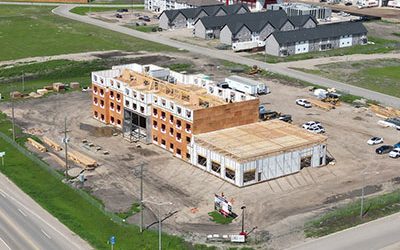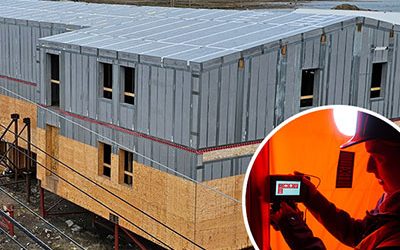The ICE Panel is an insulated composite envelope panel with a solid core of Expanded Polystyrene (EPS) or Graphite Polystyrene (GPS) with structural steel framing on both sides. Utilizing ICE Panels for a building’s envelope comes with multiple benefits beyond a simplified, prefab construction process and lightweight building materials. There are many aspects of ICE Panel construction that are also sustainable. Here are 5 ways that ICE Panels help build a sustainable future:
EPS is a closed-cell insulation. ICE Panels are composed of steel framing and EPS. Neither of these two products with rot or decay and neither will result in mould growth in high-moisture environments. EPS is hydrophobic which means it repels water and will not absorb moisture into the walls. To put this into comparison, open-cell products, such as fiberglass insulation will allow for convection to happen freely inside of it, resulting in high humidity and condensation. You never have to worry about this with ICE Panels.
EPS does not include CFCs or HFCs. By choosing ICE Panels, your home’s building envelope won’t emit CFCs or HFCs (also known as greenhouse gases) into the environment. When these harmful chemicals are released into the atmosphere, they slowly break down the ozone molecules. A home or workspace built with ICE Panels directly addresses this challenge, contributing to a healthier environment for generations to come.
ICE Panels are produced in a zero-waste facility. We’re proud to say that our manufacturing plant is a zero-waste facility. Any unused EPS or GPS is reground to be used in future panels. Because the post-processing happens in the factory, nearly zero waste is delivered to the job site, lowering the carbon footprint for both ourselves and the builder.
Utilizing ICE Panels for a building’s envelope comes with multiple benefits beyond a simplified, prefab construction process and lightweight building materials.
ICE Panels reduce the energy required for heating and cooling the space. Because ICE Panels have no thermal bridging, homeowners find they’re able to control the indoor air temperature efficiently and consistently. For example, one of our large-scale commercial projects located in the frigid northern temperatures of Arviat, Nunavut successfully heated a 27,000 sqft building with a single construction heater. This speaks volumes about one of the main benefits of ICE Panels — energy efficiency.
ICE Panel building envelopes can achieve Net-Zero standards. ICE Panels are used to help achieve high-performance building targets. They have been used to achieve Net-Zero and Net-Zero ready. In places like BC where step codes are already in place, many clients report that ICE Panels achieve a higher building envelope efficiency for a lower cost than any other methods available to date. With changes to the building codes coming to other Canadian provinces, making the switch to ICE Panel construction is a great way to ensure that your building meets or exceeds the new requirements.
If you’d like to learn more about ICE Panels, connect with our customer service team by calling 204-726-1426 or sending us a message – click here to complete our contact form.



